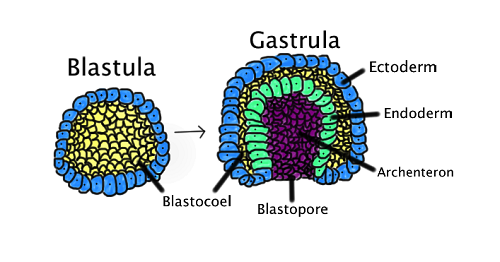Difference between Blastula and Gastrula
Introduction
In every coelomate that sexually reproduces, the process of embryogenesis has four stages: fertilization, cleavage, gastrulation and organogenesis. The process of fertilization involves the fusion of a haploid female and male gamete, which forms the diploid zygote. The zygote is the new cell, which is referred to as the fertilized ovum.
Following the fertilization event, the cleavage process involves the rapid division of the zygote, into many cells. However, it does not increase in overall size, becoming a structure known as the blastula. In mammalian organisms, this is called the blastocyst.
The continued development of this blastula, results in a structure called the gastrula, through the process of gastrulation. The gastrula has three germ layers, that interact in a variety of ways in order to form organs, representing the final stage of embryogenesis – organogenesis.
As the blastula and gastrula are different structures, present at different stages in the embryogenesis process, there are several differences that exist between the two structures.
Blastula
The blastula is the first important stage following fertilization, playing a very important role in organism development. It is a spherical and hollow structure, that is one cell thick and is formed through a process known as blastulation. Both meroblatic and holoblastic cleavages can give rise to the blastula. The cavity found within the blastula is known as the blastocoel, with its outer single-celled layer called the blastoderm.
Gastrula
A continued blastula development eventually results in the gastrula. The process of conversion of a blastula into a gastrula is known as ‘gastrulation’, which is then proceeded by organogenesis.
The gastrula is comprised of three germ layers, each of which ultimately give rise to organs in the late embryo. The three germ layers are the ectoderm, mesoderm and the endoderm. The outermost layer is the ectoderm, which later differentiates into the brain, spinal cord, skin and the nerves of the embryo. The middle layer, the mesoderm, forms connective tissues, muscles, cartilage, reproductive organs, bones, the skin dermis and teeth dentine. The innermost layer, the endoderm, differentiates into the basic primitive gut.
Difference between Blastula and Gastrula
- During the process of embryogenesis, blastula formation is followed by the gastrula, thus both represents a different stage of embryo formation.
- The blastula and gastrula are formed through different processes. The blastula is formed through blastulation, while the gastrula is formed through gastrulation.
- The blastula and gastrula are formed through different speeds of mitotic divisions. The blastula is formed through rapid mitotic divisions of the zygote, while slow mitotic divisions of the blastula results in the gastrula.
- In the process of blastula formation, the cells do not move. However, during the gastrula formation process, the cell masses move through morphogenetic movements.
- Unlike the blastula, there are three distinct germ layers that are present in the gastrula.
- Given each is present at different stages of embryogenesis, the blastula is referred to as the ‘pre-embryo’, while the gastrula is known as the ‘mature embryo’.
- The gastrula has more cells present, than in the earlier blastula stage.
- A gastrula contains differentiated cells, while the earlier blastula stage only has undifferentiated cells.
Blastula Vs Gastrula
| Blastula | Gastrula | |
| Definition | Embryo at early developmental stage | Embryo at stage after the Blastula |
| Stage in Embryogenesis | Blastulation | Gastrulation |
| Speed of Mitotic Divisions | Rapid divisions of the zygote | Slow divisions of the blastula |
| Cell Movement | Cells do not move | Cell masses move through morphogenetic movements |
| Germ Layer Presence | Not present | Three layers present |
| Embryo Reference | Pre-embryo | Mature Embryo |
| Cell Number | Less cells present | More cells present |
| Cell Differentiation | Undifferentiated | Differentiated |
Summary : Blastula and Gastrula
The Blastula is a spherical, hollow, one celled thick structure, found during the first stage of embryogenesis, and is known as the ‘pre-embryo’. The gastrula is formed during the gastrulation stage of embryogenesis, and consists of three germ layers, with the structure known as the ‘mature-embryo’.
There are a number of differences between the two structures, given that each occurs at a different stage of the embryogenesis process. Notably, the gastrula has more cells than the blastula, and is formed from slow mitotic divisions of the blastula, while the blastula itself is formed from rapid mitotic divisions of the zygote.
- Difference between Blastula and Gastrula - November 23, 2017
- Difference between Manta Ray and Stingray - October 21, 2017
- Differences between Catabolism and Anabolism - August 29, 2017
Search DifferenceBetween.net :
Leave a Response
References :
[0]Boklage, Charles E. How New Humans Are Made : Cells and Embryos, Twins and Chimeras, Left and Right, Mind/self\soul, Sex, and Schizophrenia. World Scientific, 2010.
[1]Lamouille, Samy, et al. “Molecular Mechanisms of Epithelial-Mesenchymal Transition.” Nature Reviews. Molecular Cell Biology, vol. 15, no. 3, NIH Public Access, Mar. 2014, pp. 178–96, doi:10.1038/nrm3758.
[2]Urry, L. A., et al. Campbell Biology. 11th ed., Pearson, 2017.
[3]"Image Credit: https://en.wikipedia.org/wiki/Gastrulation"

